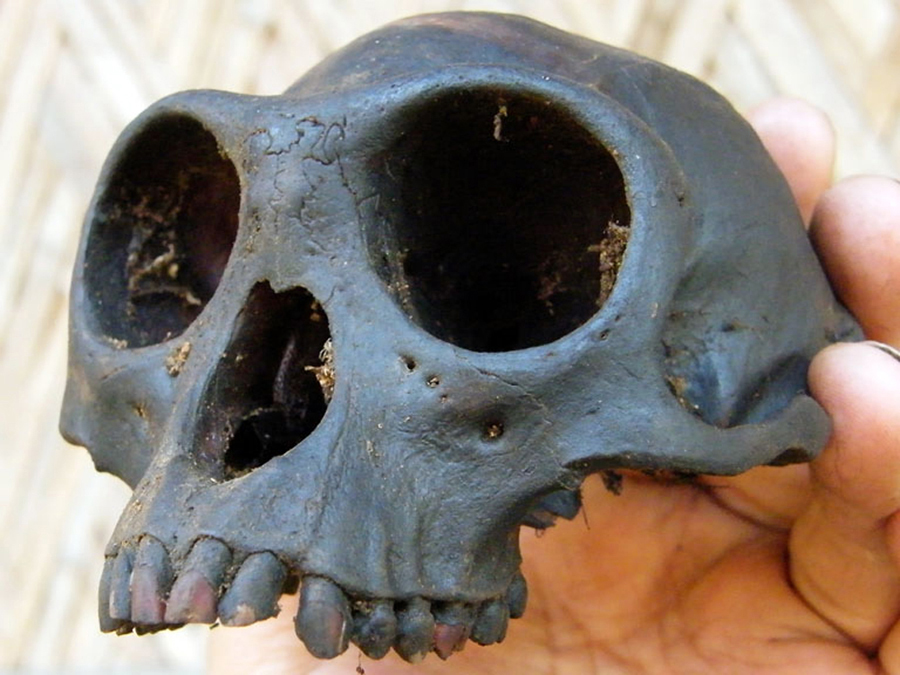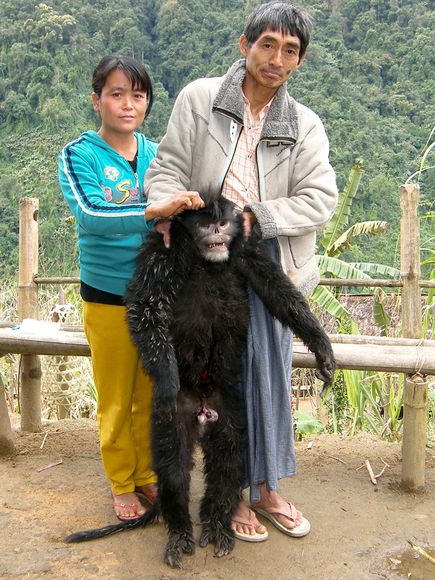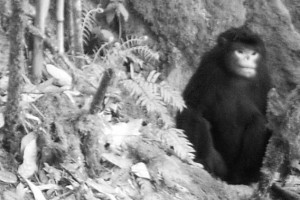First DNA Study of Snub-Nosed Monkey of Burma
Posted by: Loren Coleman on May 24th, 2012

Skull of a female Myanmar Snub-Nosed Monkey. Image: Ngwe Lwin
New Press Release:
Genetic study sheds light on evolution and may help prevent extinction of the Myanmar snub-nosed monkey
Hope for the newly discovered monkey as the Myanmar government supports a new National Park and first evidence has been secured of the primate’s existence in China
A team of scientists from the German Primate Center (DPZ), led by Dr Christian Roos, have completed genetic studies on all five snub-nosed monkey species, providing crucial information for the conservation of these rare primates.
The Myanmar snub-nosed monkey, discovered by a team from Fauna & Flora International (FFI), Biodiversity and Nature Conservation Association (BANCA) and People Resources and Conservation Foundation (PRCF) in 2010, has been of particular interest, given recent efforts in developing a conservation plan and protected areas within Myanmar, to ensure the survival of the species.
The previous scientific description of the Myanmar snub-nosed monkey, or Rhinopithecus strykeri, was based only on phenotypic characters, but now the species is also genetically confirmed as its own species.
Dr. Christian Roos, with colleagues from Switzerland, USA, China, Myanmar and Vietnam analysed the DNA of all five snub-nosed monkey species currently known to science. The genetic material was isolated from faecal samples and skin fragments, excised from museum exhibits. “We can indeed confirm that the Myanmar Snub-Nosed Monkey is a new species,” says Christian Roos.
“Even more exciting, however, is the information we gained about the evolutionary history of the species as it allows us insights into primate evolution and speciation,” Christian Roos says.
Biogeographic processes, like the raising of the Himalayas altered the landscape profoundly and created new physical and climatic barriers that certain species could not cross anymore. Therefore, gene flow was hampered and new species developed. However, the barriers were not constant over geological times and species started mixing again, resulting in hybridisation, that is the production of offspring between separate species. “Hybridisation is much more frequent than generally thought, making it necessary to adjust our species concept profoundly,” said Roos.

Next steps for ensuring the survival of the Myanmar snub-nosed monkey have now been put in place. The current political situation in Myanmar provides a unique opportunity for science and nature conservation but poses all the threats that come with accelerated economic and population growth. “This historic chance for democracy and development may also be a crossroad for nature conservation,” says Frank Momberg, FFI’s Myanmar Programme Director. With economic growth leading to more forests being cleared, “there is also the one-time chance of designating new protected areas, which the government has now agreed to, and to conduct research that was hampered for years. Myanmar is only now opening to the world.” Momberg continues.
Yet to be classified on the IUCN Red List, it is expected that the Myanmar snub-nosed monkey will be listed as Critically Endangered, with only an estimated 260 to 330 individuals surviving in the wild. All other snub-nosed monkey species are also classified as Endangered or Critically Endangered.
Hunting for food and traditional medicine as well as accelerated deforestation are the main threats for these enigmatic animals. In reaction to the discovery and population estimates, the Ministry of Environmental Conservation and Forestry and FFI organised an international workshop for the conservation of the Myanmar snub-nosed monkey in February this year.
The outcomes of the workshop were very positive, with the Myanmar government now planning to protect the species under Myanmar law and to protect its habitat by creating a new national park in the Imawbum mountain range. In addition, FFI has started a community-based conservation programme on the ground, which provides alternative livelihoods to local indigenous hunters and operates a community ranger programme to protect the species.
Previously thought to only inhabit areas of north-eastern Myanmar, a recent discovery by Liu Pu, a forest guard in Gaoligongshan National Nature Reserve, has now provided the first photographic evidence, confirmed by Chinese scientists led by Dr. Yongcheng Long that the species also exists in China. The discovery and conservation of this new primate species is of great interest for both the government of China and the government of Myanmar.
China’s State Forestry Administration is in the process of organising a field survey of the snub-nosed monkey’s distribution and population in Gaoligongshan National Nature Reserve. It also has showed a willingness to work with Myanmar’s Ministry of Environmental Conservation and Forestry to initiate a trans-boundary conservation programme.
FFI and BANCA would like to gratefully acknowledge the support of the European Union, Halycon Fund, Arcus Foundation, and Australia Zoo for supporting the conservation work of the Myanmar Snub-nosed Monkey.
Original Publications
Rasmus Liedigk, Mouyu Yang, Nina G. Jablonski, Frank Momberg, Thomas Geissmann, Ngwe Lwin, Tony Htin Hla, Zhijin Liu, Bruce Wong, Li Ming, Long Yongcheng, Ya-Ping Zhang, Tilo Nadler, Dietmar Zinner, Christian Roos: Evolutionary History of the Odd-Nosed Monkeys and the Phylogenetic Position of the Newly Described Myanmar Snub-Nosed Monkey Rhinopithecus strykeri. PLoS ONE, 5/16/2012.
Yongcheng Long, Jian Ma, Yue Wang, Yongmei Luo, Haishu Li, Guiliang Yang, and Ming Li. Rhinopithecus strykeri Found in China! American Journal of Primatology (in press)

About Loren Coleman
Loren Coleman is one of the world’s leading cryptozoologists, some say “the” leading living cryptozoologist. Certainly, he is acknowledged as the current living American researcher and writer who has most popularized cryptozoology in the late 20th and early 21st centuries.
Starting his fieldwork and investigations in 1960, after traveling and trekking extensively in pursuit of cryptozoological mysteries, Coleman began writing to share his experiences in 1969. An honorary member of Ivan T. Sanderson’s Society for the Investigation of the Unexplained in the 1970s, Coleman has been bestowed with similar honorary memberships of the North Idaho College Cryptozoology Club in 1983, and in subsequent years, that of the British Columbia Scientific Cryptozoology Club, CryptoSafari International, and other international organizations. He was also a Life Member and Benefactor of the International Society of Cryptozoology (now-defunct).
Loren Coleman’s daily blog, as a member of the Cryptomundo Team, served as an ongoing avenue of communication for the ever-growing body of cryptozoo news from 2005 through 2013. He returned as an infrequent contributor beginning Halloween week of 2015.
Coleman is the founder in 2003, and current director of the International Cryptozoology Museum in Portland, Maine.










So glad to hear that the government is taking a proactive role in protecting endangered species. I can easily see Burma/Myanmar becoming an eco-tourist hotspot which would allow them to develop economically as well as protect their natural resources.